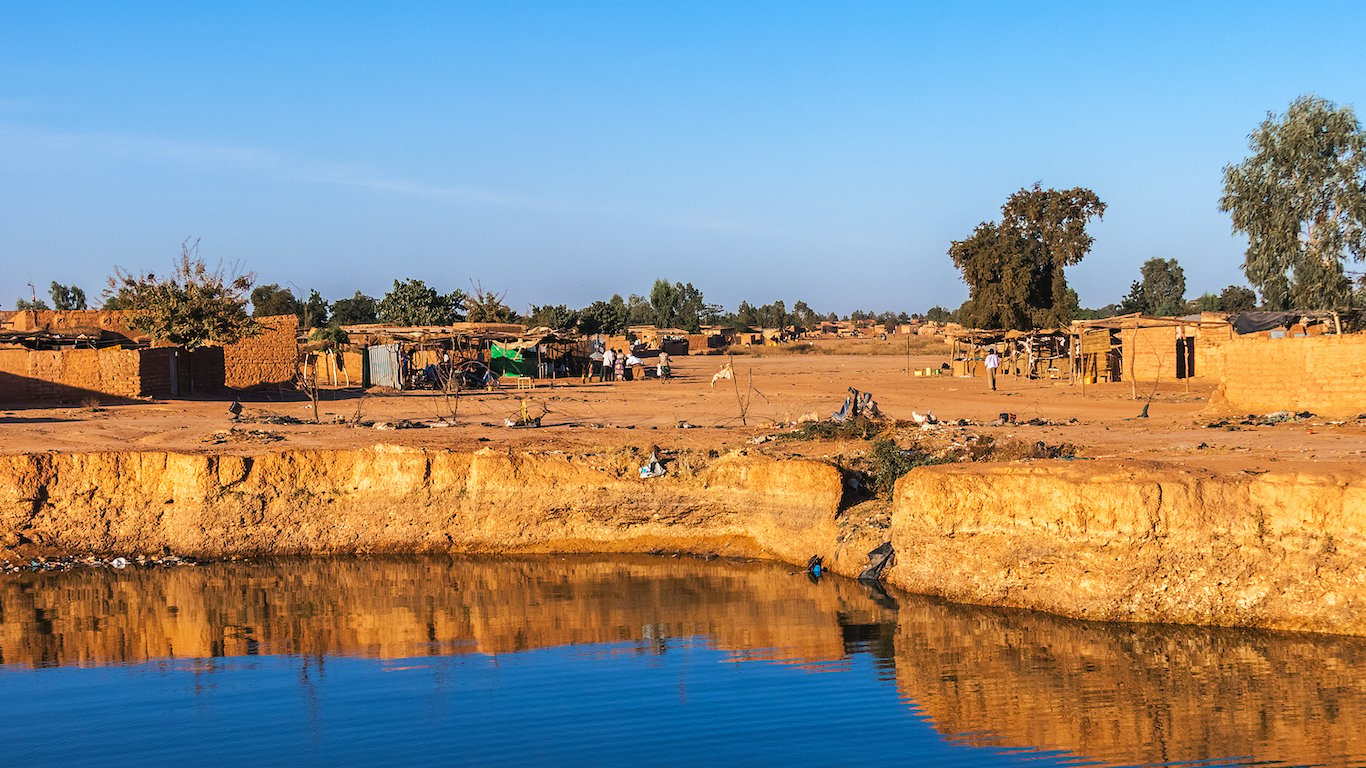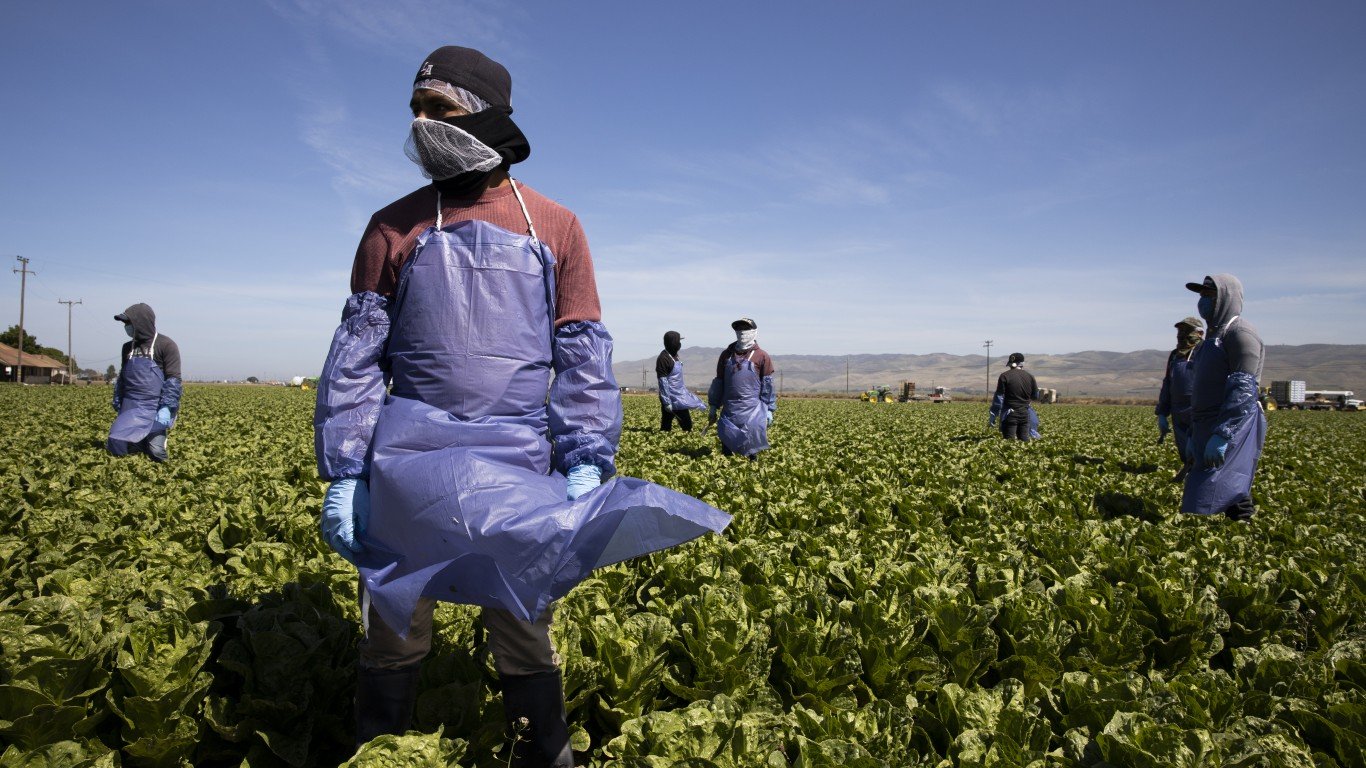

The U.S. economy reported its worst quarterly decline in modern history during the COVID-19 pandemic, with gross domestic product shrinking at an annual rate of 31.4% in the second quarter. The economy bounced back in the third quarter, but efforts to contain the virus’s spread throughout 2020 still resulted in a 3.5% annual economic contraction in the United States.
Arriving on the heels of a historic period of growth, COVID-19 brought about a decline in gross domestic product in every state in the country. However, no two state economies are alike, and partially as a result, some states were hit far harder than others.
Using data from the Bureau of Economic Analysis, 24/7 Wall St. identified the states hit hardest by the COVID-19 recession. Declines in GDP range from as little as -0.1% to as much as -8.0%, depending on the state.
The sectors hardest hit by the pandemic were those related to travel and tourism, such as arts, entertainment, recreation, accommodation, and food services. As nonessential travel ground to a halt nationwide in 2020, the sector contracted by 27.7%, more than any other. Other sectors, like oil and gas extraction, were also hard hit by public health measures, as reduced demand for fuel gave way to plummeting oil prices. These are the 27 most traveled countries before the pandemic.
As economic output fell nationwide, millions of Americans lost their jobs. Overall employment declined by 5.8% in 2020. While the April national unemployment rate declined to 6.1%, a considerable improvement to the peak-pandemic rate of 14.8%, the U.S. has a long way to go before returning to full employment. Here is a look at the 39 states where people gave up looking for work during the pandemic.
Click here to see the state economies hit hardest by the COVID-19 recession.
Click here to see our detailed methodology.

50. Utah
> 1-yr. GDP change: -0.1%
> 2020 GDP: $168.6 billion (20th smallest)
> Fastest shrinking industry, 2019-2020: Arts, entertainment, recreation, accommodation, and food services (-22.3%)
> Fastest growing industry, 2019-2020: Construction (+9.4%)
> April 2021 unemployment: 2.8% (4th lowest)
Utah’s economy contracted by 0.1% in 2020, the smallest decline of any state. Due in large part to shutdowns of nonessential travel during the COVID-19 pandemic, the state’s arts, entertainment, recreation, accommodation, and food services sector contracted by 22.3% over that period, more than any other industry. Declines in industries related to tourism were partially offset, however, by growth in the state’s construction, information, and real estate sectors.
Economic contraction contributed to job losses in Utah. Overall employment fell by 1.6% from 2019 to 2020 in the state. Despite the decline, Utah’s job market is relatively strong. As of April, unemployment in the state stood at 2.8%, less than half the 6.1% U.S. jobless rate.
[in-text-ad]

49. Washington
> 1-yr. GDP change: -0.7%
> 2020 GDP: $544.6 billion (8th largest)
> Fastest shrinking industry, 2019-2020: Arts, entertainment, recreation, accommodation, and food services (-28.2%)
> Fastest growing industry, 2019-2020: Utilities (+13.9%)
> April 2021 unemployment: 5.5% (22nd highest)
Washington is one of only three states where GDP fell by less than 1% between 2019 and 2020. Steep declines in the industries hit hardest by the COVID-19 pandemic were partially offset by growth in sectors like utilities and agriculture.
Washington is also home to some of the largest tech companies in the world, some of which reported strong earnings during the pandemic, such as Amazon and Microsoft. Partially as a result, the information sector was by far the largest contributor to growth in the last year, contributing to a net increase of 2.2 percentage points in GDP.

48. Arizona
> 1-yr. GDP change: -0.9%
> 2020 GDP: $320.7 billion (19th largest)
> Fastest shrinking industry, 2019-2020: Arts, entertainment, recreation, accommodation, and food services (-20.9%)
> Fastest growing industry, 2019-2020: Agriculture, forestry, fishing and hunting (+7.9%)
> April 2021 unemployment: 6.7% (11th highest)
Arizona’s 0.9% economic contraction in 2020 ranks as the third smallest among states. While sectors like entertainment and travel were hit hard due to pandemic-related shutdowns, other industries, like agriculture, information, and utilities thrived. During a period of mass layoffs across multiple industries, employment in Arizona’s utilities sector expanded by 9.4%, more than any other industry in the state and the sector’s strongest job growth in the country.
Due in part to strong job growth in the state’s utilities sector, overall employment fell by just 3.1% in Arizona in 2020, well below the 5.8% employment decline nationwide that year.

47. Idaho
> 1-yr. GDP change: -1.1%
> 2020 GDP: $74.1 billion (12th smallest)
> Fastest shrinking industry, 2019-2020: Arts, entertainment, recreation, accommodation, and food services (-20.9%)
> Fastest growing industry, 2019-2020: Utilities (+12.2%)
> April 2021 unemployment: 3.1% (6th lowest)
Idaho’s economy contracted by 1.1% in 2020, a far smaller decline than most other states and less than one-third the comparable national economic contraction. Population growth can drive economic growth, and there are tens of thousands of more people living in Idaho today than there were last year. The state’s one-year population growth of 2.1% was the highest of any state over that period.
Population growth likely helped fuel Idaho’s construction industry. The sector’s output grew by 6.1% in 2020 and contributed 0.3 percentage points to overall GDP growth — a larger overall net contribution to the state’s economy than any other industry.
[in-text-ad-2]

46. Colorado
> 1-yr. GDP change: -1.5%
> 2020 GDP: $351.1 billion (16th largest)
> Fastest shrinking industry, 2019-2020: Arts, entertainment, recreation, accommodation, and food services (-24.0%)
> Fastest growing industry, 2019-2020: Information (+12.5%)
> April 2021 unemployment: 6.4% (15th highest)
Colorado’s economy contracted by just 1.5% in 2020, the fifth smallest decline among states. Strong growth in Colorado’s information sector helped offset steep declines in industries related to tourism.
While Colorado’s decline in economic output was modest relative to most states, job losses were steeper. Due in part to the mining and logging industry, which shed nearly a quarter of its workforce in Colorado throughout 2020, overall employment in the state fell by 5.2% from 2019 to 2020, only slightly lower than the 5.8% national employment decline during that time. As of April, unemployment in Colorado stood at 6.4%, compared to the 6.1% U.S. unemployment rate.
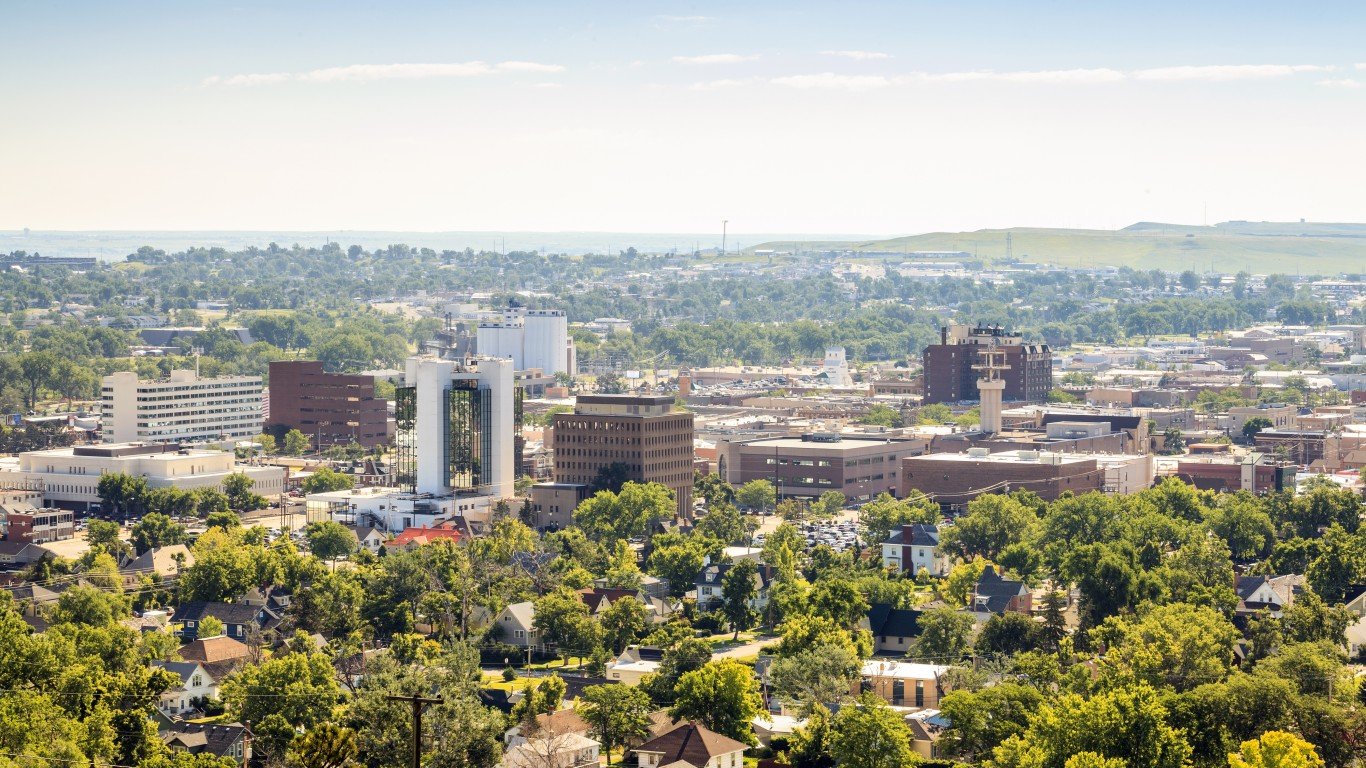
45. South Dakota
> 1-yr. GDP change: -1.7%
> 2020 GDP: $46.8 billion (4th smallest)
> Fastest shrinking industry, 2019-2020: Arts, entertainment, recreation, accommodation, and food services (-18.6%)
> Fastest growing industry, 2019-2020: Agriculture, forestry, fishing and hunting (+17.5%)
> April 2021 unemployment: 2.8% (4th lowest)
Economic output in South Dakota fell by 1.7% from 2019 to 2020. The three largest drags on the state’s economy over the last year were the arts, entertainment, and hospitality, educational services, and real estate sectors. Meanwhile, agriculture, construction, and utilities were net positives on economic growth.
Overall employment in the state dipped by 3.4% in 2020, with the steepest job losses in the hospitality industry. Still, South Dakota’s job market remains one of the strongest in the country with unemployment at just 2.8% — less than half the 6.1% national jobless rate.
[in-text-ad]

44. Nebraska
> 1-yr. GDP change: -2.1%
> 2020 GDP: $115.0 billion (17th smallest)
> Fastest shrinking industry, 2019-2020: Arts, entertainment, recreation, accommodation, and food services (-21.6%)
> Fastest growing industry, 2019-2020: Mining, quarrying, and oil and gas extraction (+14.9%)
> April 2021 unemployment: 2.8% (4th lowest)
Nebraska’s economy contracted by 2.1% in 2020. The largest detractors to GDP growth were the sectors most affected by efforts to contain the spread of the coronavirus. For example, transportation accounted for a net 1.3 percentage point decline in the state’s GDP, and arts, entertainment, recreation, accommodation, and food services, which contracted more than any other industry in the state, dragged Nebraska’s GDP down by half a percentage point.
Due in large part to layoffs in many of the state’s fastest shrinking industries, employment declined 3.6% in Nebraska year over year. The state’s leisure and hospitality industry alone shed 15,000 jobs in 2020r. Still, unemployment in Nebraska stands at 2.8%, tied with three other states as the lowest in the country.

43. Iowa
> 1-yr. GDP change: -2.3%
> 2020 GDP: $169.5 billion (21st smallest)
> Fastest shrinking industry, 2019-2020: Arts, entertainment, recreation, accommodation, and food services (-24.2%)
> Fastest growing industry, 2019-2020: Agriculture, forestry, fishing and hunting (+9.9%)
> April 2021 unemployment: 3.8% (10th lowest)
Iowa is one of only eight states to report an economic contraction of less than 2.5% in 2020. Iowa’s 2020 GDP of $169.5 billion was 2.3% lower than it was in 2019. Efforts to contain the spread of the coronavirus slowed economic activity in the state. Two of the industries that detracted the most from growth were transportation and arts, entertainment, recreation, accommodation, and food services.
Just as economic decline was not as steep in Iowa as in much of the rest of the country, neither were job losses. Employment fell by 5.1% in the state in the last year, below the 5.8% national decline.

42. Virginia
> 1-yr. GDP change: -2.5%
> 2020 GDP: $476.9 billion (13th largest)
> Fastest shrinking industry, 2019-2020: Arts, entertainment, recreation, accommodation, and food services (-24.5%)
> Fastest growing industry, 2019-2020: Utilities (+4.5%)
> April 2021 unemployment: 4.7% (21st lowest)
Virginia’s economy contracted by 2.5% between 2019 and 2020. Declines in sectors related to entertainment and tourism were steep enough to offset gains in construction and utilities — the only two sectors in the state that expanded in 2020.
Employment declines were even more pronounced in Virginia. The state’s leisure and hospitality sector shed over one-fifth of its workforce, and partially as a result, overall employment declined by 5.0%.
[in-text-ad-2]

41. North Carolina
> 1-yr. GDP change: -2.5%
> 2020 GDP: $498.7 billion (12th largest)
> Fastest shrinking industry, 2019-2020: Arts, entertainment, recreation, accommodation, and food services (-27.4%)
> Fastest growing industry, 2019-2020: Utilities (+3.7%)
> April 2021 unemployment: 5.0% (24th highest)
Along with neighboring Georgia and Virginia, North Carolina’s economy contracted by 2.5% in 2020. Also like its neighbors that reported similar economic contractions, the fastest growing industry in the state was utilities, which expanded by 3.7%, and the fastest shrinking industry was arts, entertainment, recreation, accommodation, and food services, which contracted by 27.4%.
Employment in North Carolina has also fallen in 2020, by 4.3%, resulting in a loss of nearly 200,000 jobs. Still, the state’s monthly unemployment stands at 5.0%, slightly less than the 6.1% U.S. jobless rate.

40. Georgia
> 1-yr. GDP change: -2.5%
> 2020 GDP: $533.6 billion (10th largest)
> Fastest shrinking industry, 2019-2020: Arts, entertainment, recreation, accommodation, and food services (-20.2%)
> Fastest growing industry, 2019-2020: Utilities (+6.1%)
> April 2021 unemployment: 4.3% (17th lowest)
Economic output fell by 2.5% in Georgia in 2020, a smaller contraction than in most states. The smaller than average economic decline during the COVID-19 pandemic in the state was due in part to strong performances in the utilities and finance, insurance, and real estate sectors, which each had a net positive impact on economic growth in the state. Declines in industries hard-hit by the pandemic like transportation and entertainment, recreation, and hospitality were also less pronounced in Georgia than they were nationwide.
Economic decline brought about job losses in Georgia. Overall employment in the state fell by 4.6%, or 214,000 jobs, in 2020.
[in-text-ad]

39. Arkansas
> 1-yr. GDP change: -2.6%
> 2020 GDP: $114.4 billion (16th smallest)
> Fastest shrinking industry, 2019-2020: Arts, entertainment, recreation, accommodation, and food services (-17.7%)
> Fastest growing industry, 2019-2020: Utilities (+11.2%)
> April 2021 unemployment: 4.4% (18th lowest)
Arkansas’ annual GDP stands at $114.4 billion — 2.6% lower than it was in 2019. As was the case in many states, arts, entertainment, recreation, accommodation, and food services was the fastest shrinking industry in Arkansas in 2020. Over the course of the year, as nonessential travel effectively ground to a halt in much of the country, the sector contracted by 17.7%. However, no industry had a greater negative impact on Arkansas’ economy than manufacturing, which accounted for a 0.6 percentage point contraction in the state’s total GDP.
Economic decline in Arkansas resulted in relatively minimal job losses. Overall employment in the state fell by 3.0% in 2020, compared to 5.8% nationwide.
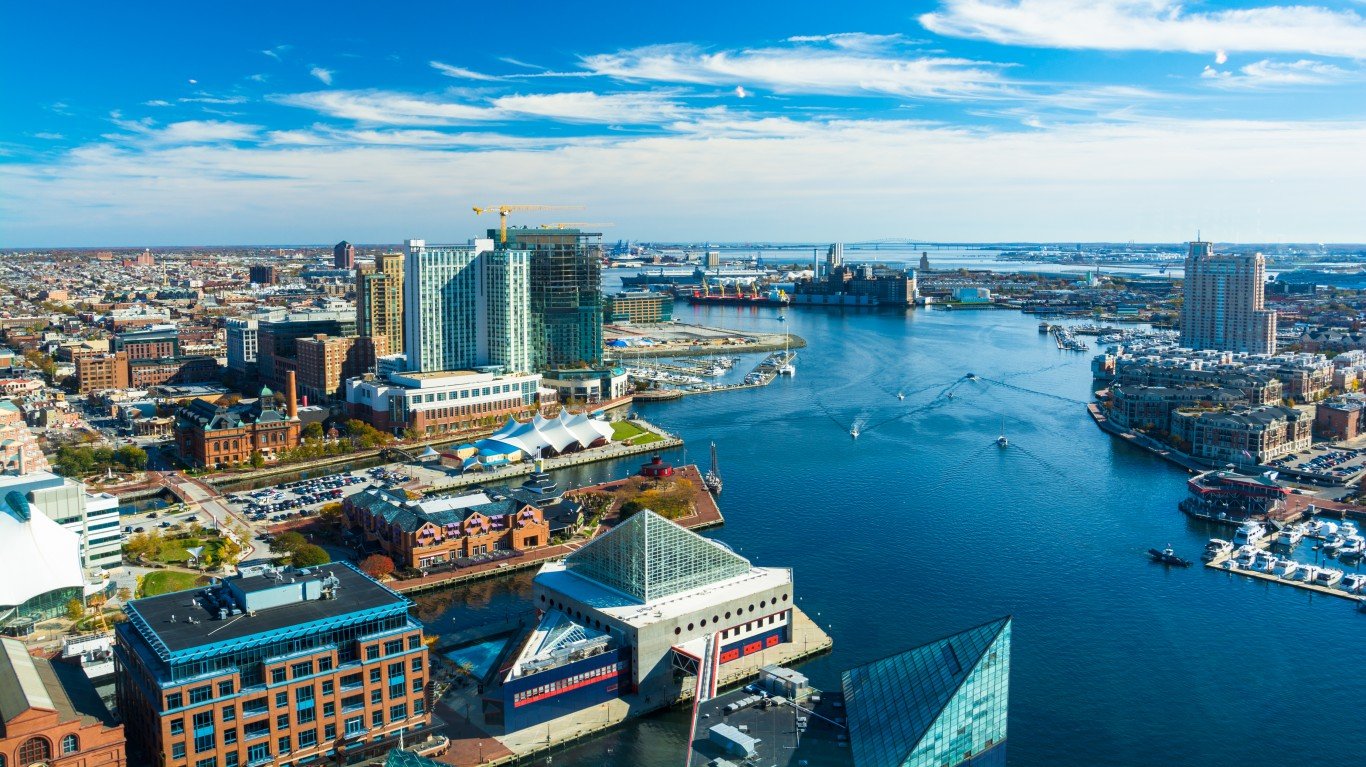
38. Maryland
> 1-yr. GDP change: -2.6%
> 2020 GDP: $364.2 billion (15th largest)
> Fastest shrinking industry, 2019-2020: Arts, entertainment, recreation, accommodation, and food services (-25.6%)
> Fastest growing industry, 2019-2020: Agriculture, forestry, fishing and hunting (+7.0%)
> April 2021 unemployment: 6.2% (18th highest)
Maryland’s economy contracted by nearly $9.9 billion in 2020, or 2.6%. While the state’s economic decline was less pronounced than in most of the rest of the country, job losses were relatively steep. Overall employment fell by 6.8% in Maryland in 2020, a full percentage point greater than the comparable 5.8% employment decline nationwide. There were nearly 190,000 fewer jobs in Maryland in 2020 than there were in 2019.
Job losses hit the state’s leisure and hospitality sector especially hard, with more than one in every four jobs in the industry gone. Information and retail trade followed, with 7.9% and 8.2% employment declines, respectively.
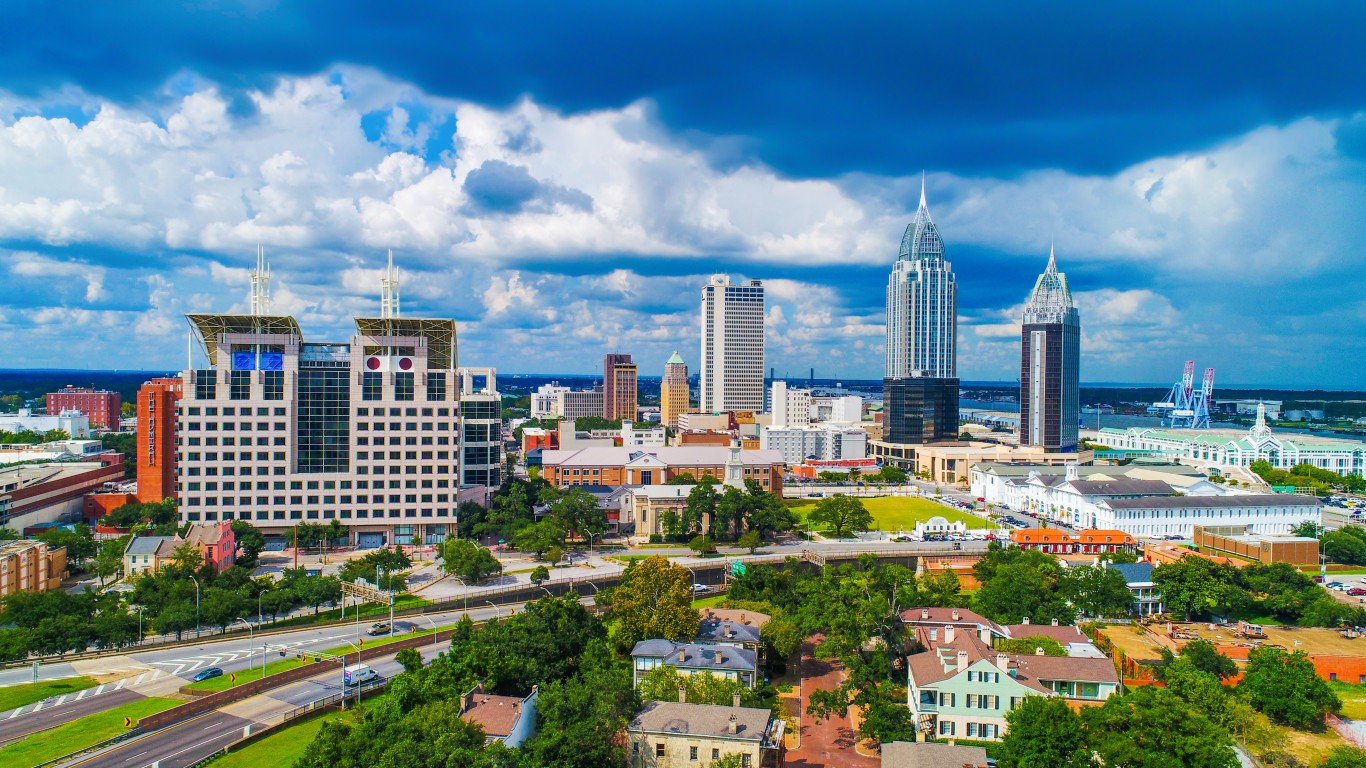
37. Alabama
> 1-yr. GDP change: -2.7%
> 2020 GDP: $195.5 billion (24th smallest)
> Fastest shrinking industry, 2019-2020: Arts, entertainment, recreation, accommodation, and food services (-23.2%)
> Fastest growing industry, 2019-2020: Agriculture, forestry, fishing and hunting (+4.3%)
> April 2021 unemployment: 3.6% (8th lowest)
Alabama is one of only 18 states with an economy that reported a contraction of less than 3% in 2020. Alabama’s GDP from $200.8 billion in 2019 to $195.5 billion in 2020, a 2.7% decline. As was the case in most states, Alabama’s arts, entertainment, recreation, accommodation, and food services contracted the most due to steep reductions in nonessential travel during the pandemic. Economic decline in many sectors Alabama was offset partially by growth in the agriculture, utilities, and professional business services sectors.
Over the course of the last year, Alabama shed 89,000 jobs, or 4.3% of its workforce. Still, the state’s 3.6% unemployment rate is among the lowest in the country.
[in-text-ad-2]
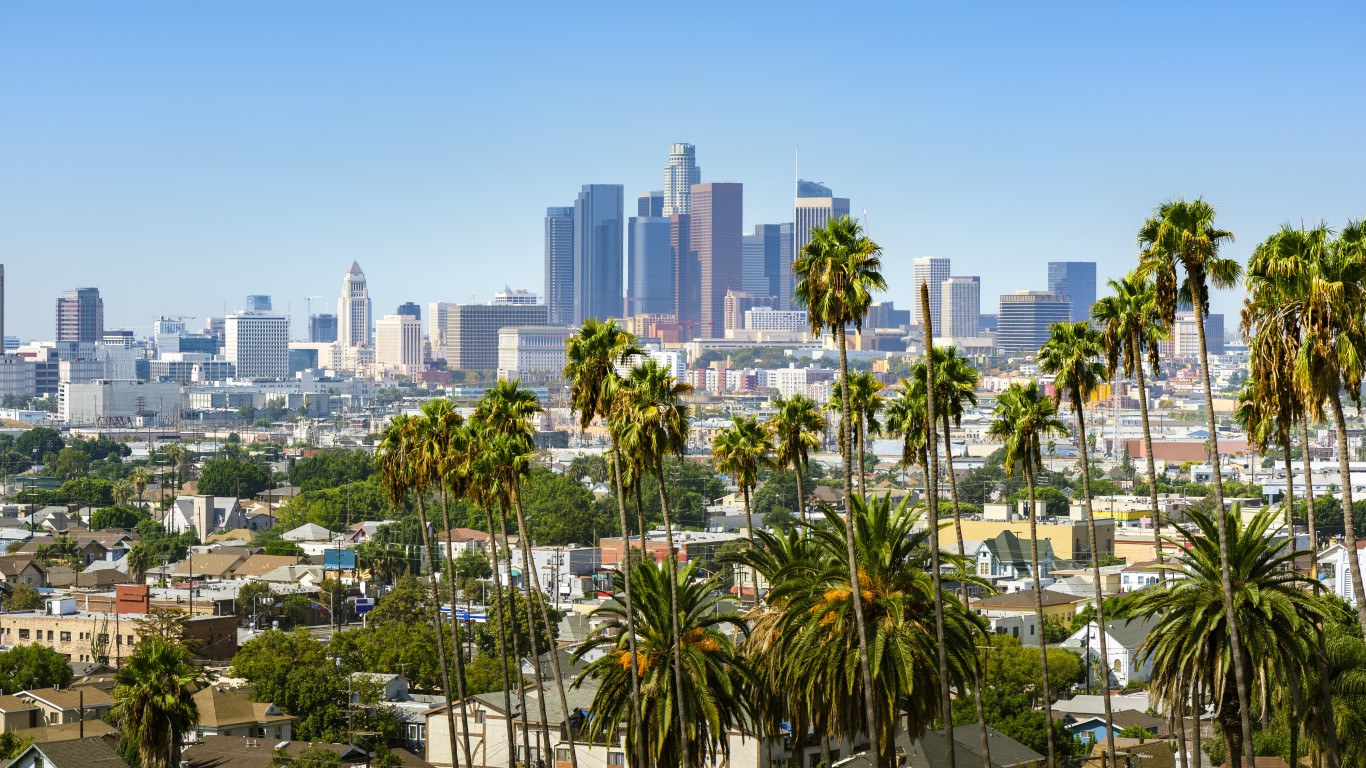
36. California
> 1-yr. GDP change: -2.8%
> 2020 GDP: $2.7 trillion (the largest)
> Fastest shrinking industry, 2019-2020: Arts, entertainment, recreation, accommodation, and food services (-28.9%)
> Fastest growing industry, 2019-2020: Agriculture, forestry, fishing and hunting (+8.7%)
> April 2021 unemployment: 8.3% (2nd highest)
California’s GDP declined to $2.7 trillion in 2020. The staggering $77.7 billion drop is a larger decline than the entire annual economic output of over a dozen states. Still, as California’s economy is by far the largest of any state, its contraction in 2020 amounted to just 2.8%, a smaller decline than most states reported.
While economic decline in California was less pronounced than in much of the country, the state’s job market was hit especially hard. Overall employment fell by 7.4% in the state in 2020. Due to mass layoffs in services, retail trade, and hospitality, there were nearly 1.3 million fewer people working in California on average in 2020 than there were in 2019.

35. Mississippi
> 1-yr. GDP change: -2.8%
> 2020 GDP: $99.8 billion (15th smallest)
> Fastest shrinking industry, 2019-2020: Arts, entertainment, recreation, accommodation, and food services (-20.2%)
> Fastest growing industry, 2019-2020: Utilities (+13.4%)
> April 2021 unemployment: 6.2% (18th highest)
Economic output in Mississippi fell from $102.7 billion in 2019 to $99.8 billion in 2020. The 2.8% economic contraction was not as steep as in most other states. As was the case in much of the country, the fastest-growing industry in the Mississippi was utilities, which expanded by 13.4%, and the fastest-shrinking industry was arts, entertainment, recreation, accommodation, and food services, which contracted by 20.2%.
Just as Mississippi’s economic decline was relatively modest, so too were job losses in the state. Overall employment fell by 4.3% in 2020, as the state lost 50,000 jobs. Nationwide, employment fell by 5.8%.
[in-text-ad]

34. Oregon
> 1-yr. GDP change: -2.8%
> 2020 GDP: $219.0 billion (25th largest)
> Fastest shrinking industry, 2019-2020: Arts, entertainment, recreation, accommodation, and food services (-29.5%)
> Fastest growing industry, 2019-2020: Agriculture, forestry, fishing and hunting (+9.2%)
> April 2021 unemployment: 6.0% (20th highest)
Oregon’s economy was spared some of the worst effects of the COVID-19 pandemic, as economic output fell by 2.8% in 2020 — a smaller contraction than in most other states. The relatively small decline was due in part to rapid growth in the state’s agricultural sector, which expanded by 9.2% and contributed a net 0.2 percentage points increase to the state’s GDP. Other positive growth sectors in the state included the information and utilities sectors.
Despite relatively limited declines in economic output, employment in Oregon fell by 6.6% in 2020, considerably more than the 5.8% national decline. Oregon’s monthly unemployment rate of 6.0% is closely in line with the comparable 6.1% national rate.

33. Florida
> 1-yr. GDP change: -2.9%
> 2020 GDP: $935.7 billion (4th largest)
> Fastest shrinking industry, 2019-2020: Arts, entertainment, recreation, accommodation, and food services (-22.2%)
> Fastest growing industry, 2019-2020: Utilities (+8.6%)
> April 2021 unemployment: 4.8% (23rd lowest)
Florida’s economy contracted by 2.9% in 2020. Few state economies rely more heavily on tourism than Florida’s, and last year, the state’s arts, entertainment, recreation, accommodation, and food services sector reported a 22.2% decline in output — resulting in a 1.3 percentage point net decline in the state’s overall GDP. Florida’s transportation and warehousing sector shaved an additional 0.3 percentage points off overall economic growth.
Overall employment in Florida fell by 5.2% in 2020. Meanwhile, the number of jobs nationwide fell by 5.8% over the same period.

32. Kansas
> 1-yr. GDP change: -3.0%
> 2020 GDP: $155.3 billion (19th smallest)
> Fastest shrinking industry, 2019-2020: Arts, entertainment, recreation, accommodation, and food services (-24.9%)
> Fastest growing industry, 2019-2020: Agriculture, forestry, fishing and hunting (+5.6%)
> April 2021 unemployment: 3.5% (7th lowest)
Economic output in Kansas fell from $160.1 billion in 2019 to $155.3 billion in 2020. The 3.0% economic contraction was not as steep as in most states. As was the case in much of the country, the fastest shrinking industry in Kansas was arts, entertainment, recreation, accommodation, and food services, which contracted by 24.9% — resulting in a 0.7 net drag on overall economic growth.
Agriculture and forestry, as well as manufacturing, were economic boons for Kansas in 2020. Combined, the two sectors contributed half a percentage point to GDP growth.
[in-text-ad-2]
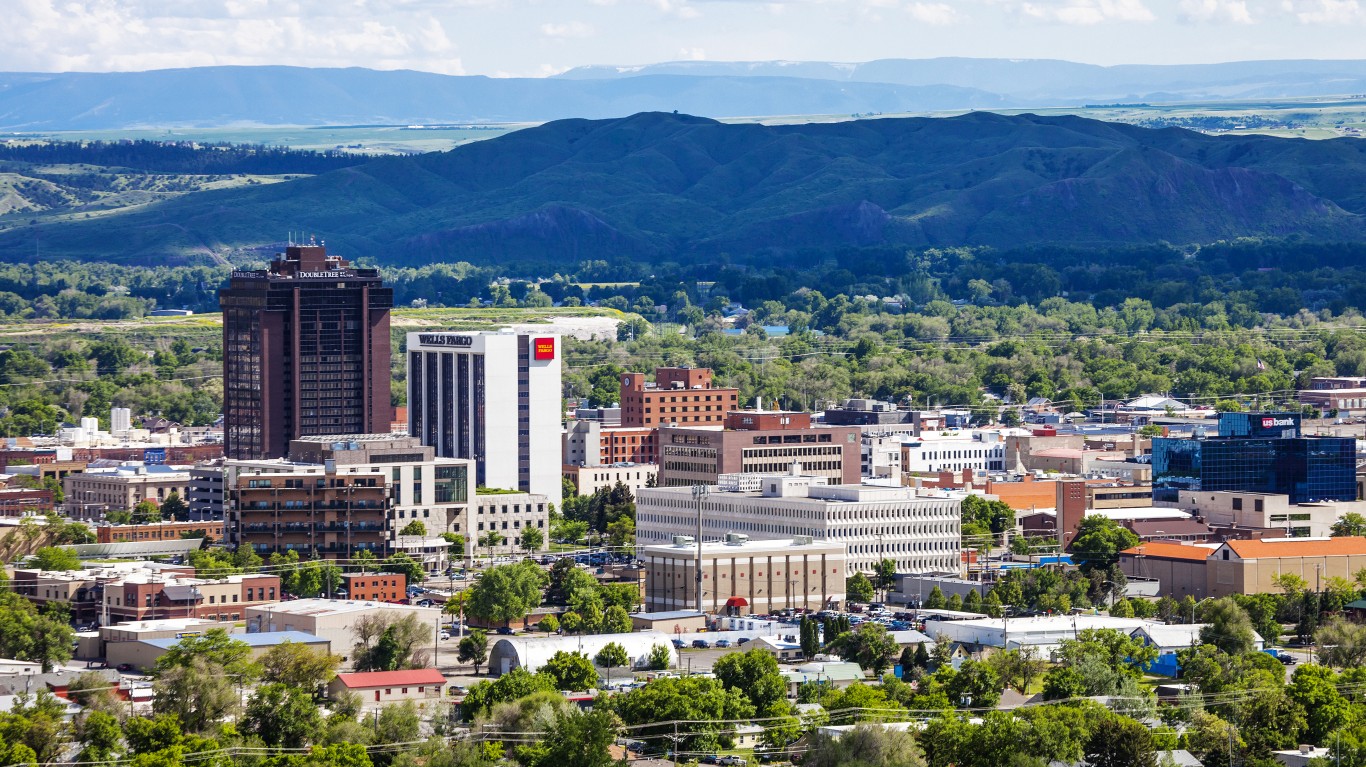
31. Montana
> 1-yr. GDP change: -3.0%
> 2020 GDP: $46.5 billion (3rd smallest)
> Fastest shrinking industry, 2019-2020: Arts, entertainment, recreation, accommodation, and food services (-21.5%)
> Fastest growing industry, 2019-2020: Agriculture, forestry, fishing and hunting (+14.0%)
> April 2021 unemployment: 3.7% (9th lowest)
Montana’s economy contracted by 3.0%, or $1.4 billion, in 2020. The largest drags on growth in the state were the arts, entertainment, recreation, accommodation, and food services, transportation and warehousing, and educational services sectors.
Job losses in Montana were proportional to economic declines. The number of people working in the state fell by 15,000, or 3.1%, in 2020. Job losses were most pronounced in the state’s leisure and hospitality and mining and logging sectors. As of April, Montana’s unemployment rate was 3.7%, well below the 6.1% rate nationwide.
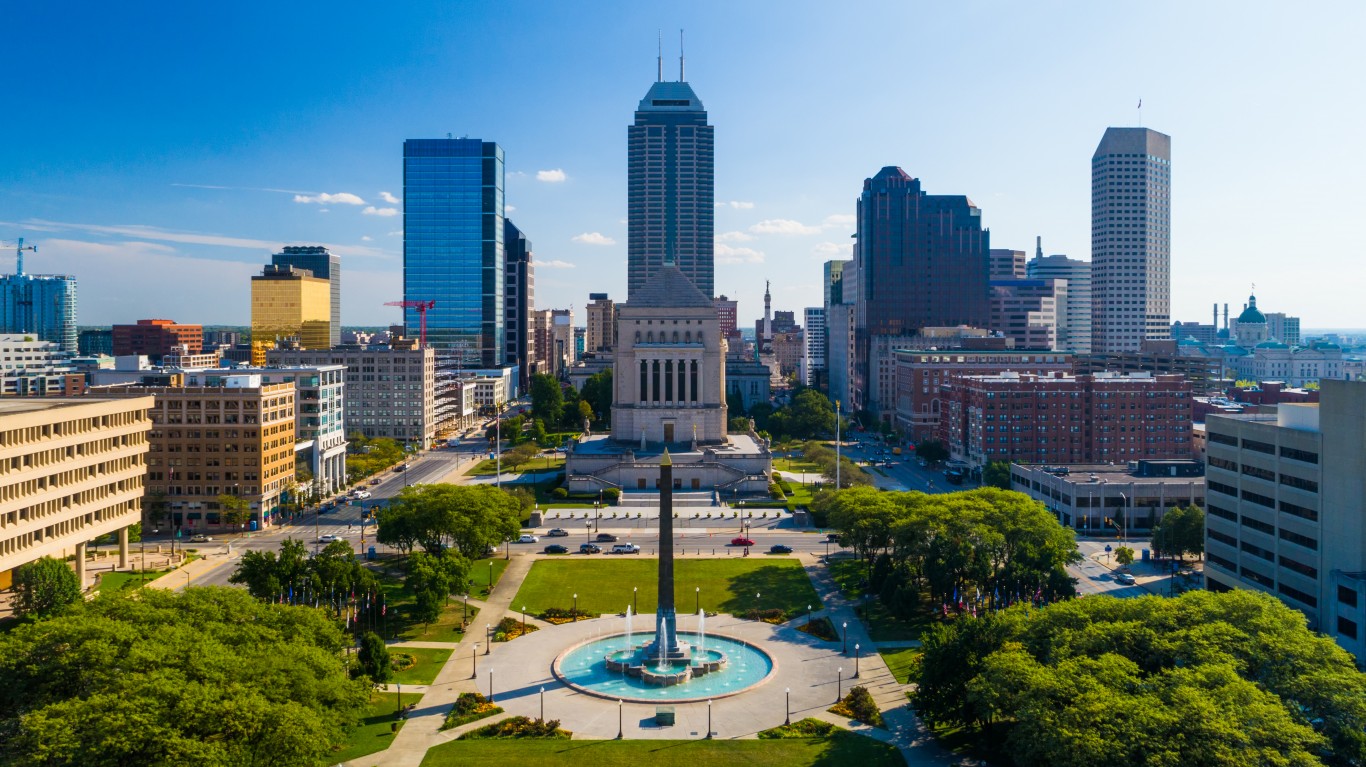
30. Indiana
> 1-yr. GDP change: -3.1%
> 2020 GDP: $327.3 billion (18th largest)
> Fastest shrinking industry, 2019-2020: Arts, entertainment, recreation, accommodation, and food services (-21.2%)
> Fastest growing industry, 2019-2020: Agriculture, forestry, fishing and hunting (+45.7%)
> April 2021 unemployment: 3.9% (12th lowest)
Economic output in Indiana fell from $337.6 billion in 2019 to $327.3 billion in 2020. The 3.1% economic contraction was not as steep as it was in slightly over half of all states. Industries like arts, entertainment, recreation, accommodation, and food services and manufacturing were considerable drags on growth.
However, the overall damage to economic growth was mitigated by the state’s agricultural industry, which surged by 45.7%, contributing 0.7 percentage points to overall GDP growth. Indiana’s job market remains relatively strong despire reporting a 5.5% drop in employment last year. As of April, 3.9% of the state’s labor force were unemployed, well below the 6.1% U.S. jobless rate.
[in-text-ad]

29. New Mexico
> 1-yr. GDP change: -3.1%
> 2020 GDP: $95.7 billion (14th smallest)
> Fastest shrinking industry, 2019-2020: Arts, entertainment, recreation, accommodation, and food services (-20.1%)
> Fastest growing industry, 2019-2020: Utilities (+7.3%)
> April 2021 unemployment: 8.2% (3rd highest)
Montana’s economy contracted by 3.1%, or $3.0 billion, in 2020. Two of the largest drags on growth in the state were the arts, entertainment, recreation, accommodation, and food services, and educational services sectors. The largest detractor from growth, however, was the state’s resource extraction sector. The state is a major petroleum producer, and though it was one of only three states to report an increase in production in 2020, oil prices cratered during the pandemic. Likely partially as a result, New Mexico’s mining, quarrying, and oil and gas extraction sector dragged the state’s overall GDP down by 2.1 percentage points.
Resource extraction also shed more jobs than any other industry in New Mexico in 2020 as overall employment in the sector declined by 23.6%. The state’s information and leisure and hospitality sectors also shed about one-fifth of their workforce.

28. Texas
> 1-yr. GDP change: -3.5%
> 2020 GDP: $1.7 trillion (2nd largest)
> Fastest shrinking industry, 2019-2020: Agriculture, forestry, fishing and hunting (-22.2%)
> Fastest growing industry, 2019-2020: Finance, insurance, real estate, rental, and leasing (+0.1%)
> April 2021 unemployment: 6.7% (11th highest)
Texas’ economy contracted by 3.5% in 2020, in line with the comparable GDP decline nationwide. Texas is far and away the top oil-producing state, and as nonessential travel ground to a halt during the pandemic, demand for petroleum plummeted, putting pressure on oil prices. Though several industries in Texas contracted more than resource extraction, due to the industry’s size, it posed the largest drag on overall economic growth, detracting 1.7 percentage points from the state’s GDP.
Resource extraction also shed more jobs than any other industry in Texas in 2020, as overall employment in the sector declined by 22.8%. Partially as a result, unemployment in Texas stands at 6.7%, considerably higher than the 6.1% U.S. jobless rate.

27. North Dakota
> 1-yr. GDP change: -3.5%
> 2020 GDP: $52.0 billion (7th smallest)
> Fastest shrinking industry, 2019-2020: Arts, entertainment, recreation, accommodation, and food services (-21.5%)
> Fastest growing industry, 2019-2020: Agriculture, forestry, fishing and hunting (+24.0%)
> April 2021 unemployment: 4.2% (15th lowest)
The only two sectors in North Dakota to report growth were agriculture and utilities, which expanded by 24.0% and 2.2%, respectively. With most industries contracting, North Dakota’s economic output fell by $1.9 billion, or 3.5%, in 2020.
North Dakota is the second largest producer of crude oil in the United States, and like other major oil-producing states, economic decline in the state in 2020 was tied largely to the sector’s slowdown. As the pandemic slashed demand for fossil fuels, global oil prices cratered. Partially as a result, North Dakota’s resource extraction industry contracted by 14.5% in 2020. While other industries in the state reported larger output declines, resource extraction was the largest drag on growth in the state, detracting 2.3 percentage points from GDP.
[in-text-ad-2]

26. Missouri
> 1-yr. GDP change: -3.6%
> 2020 GDP: $277.4 billion (22nd largest)
> Fastest shrinking industry, 2019-2020: Arts, entertainment, recreation, accommodation, and food services (-22.6%)
> Fastest growing industry, 2019-2020: Agriculture, forestry, fishing and hunting (+3.4%)
> April 2021 unemployment: 4.1% (14th lowest)
Missouri’s economy contracted by 3.6% in 2020, closely in line with the national GDP decline and near the median among all states. The largest drags on growth in the state were the arts, entertainment, recreation, accommodation, and food services and manufacturing sectors, which detracted a combined 1.5 percentage points from GDP.
As Missouri’s economy contracted, the state shed some 141,000 jobs, or 4.8% of its workforce. Still, the state’s unemployment rate of 4.1% is considerably lower than the 6.1% national rate.

25. Kentucky
> 1-yr. GDP change: -3.7%
> 2020 GDP: $183.8 billion (22nd smallest)
> Fastest shrinking industry, 2019-2020: Arts, entertainment, recreation, accommodation, and food services (-22.0%)
> Fastest growing industry, 2019-2020: Agriculture, forestry, fishing and hunting (+9.8%)
> April 2021 unemployment: 4.7% (21st lowest)
Economic output in Kentucky fell from $190.8 billion in 2019 to $183.8 billion in 2020. The 3.7% economic contraction was steeper than it was in about half of all states. Industries like arts, entertainment, recreation, accommodation, and food services, educational services, and transportation and warehousing were considerable drags on growth.
Not all sectors in Kentucky contracted in the last year, however. The state’s agriculture industry expanded by nearly 10% in 2020, and the utilities sector expanded by nearly 9%.
[in-text-ad]

24. Minnesota
> 1-yr. GDP change: -3.7%
> 2020 GDP: $328.5 billion (17th largest)
> Fastest shrinking industry, 2019-2020: Arts, entertainment, recreation, accommodation, and food services (-26.1%)
> Fastest growing industry, 2019-2020: Agriculture, forestry, fishing and hunting (+15.6%)
> April 2021 unemployment: 4.1% (14th lowest)
Minnesota’s annual GDP stands at $328.5 billion — 3.7% lower than it was in 2019. As was the case in many states, arts, entertainment, recreation, accommodation, and food services was the fastest shrinking industry in Minnesota in 2020. Over the course of the year, as nonessential travel effectively ground to a halt in much of the country, the sector contracted by 26.1% in the state, posing a 0.8 percentage point drag on the state’s GDP growth.
As the state’s economy contracted, employment fell at an even faster rate. There were 207,000 fewer people working in Minnesota in 2020 than in 2019, a 6.9% reduction in jobs. Nationwide, employment fell by just 5.8% last year. Still, Minnesota’s job market is relatively strong with just a 4.1% unemployment rate, 2 percentage points below the 6.1% national rate.

23. Massachusetts
> 1-yr. GDP change: -3.8%
> 2020 GDP: $500.2 billion (11th largest)
> Fastest shrinking industry, 2019-2020: Arts, entertainment, recreation, accommodation, and food services (-30.1%)
> Fastest growing industry, 2019-2020: Agriculture, forestry, fishing and hunting (+10.4%)
> April 2021 unemployment: 6.4% (14th highest)
Massachusetts reported a 3.8% economic contraction in 2020, slightly larger than the comparable national GDP decline. The state’s arts, entertainment, recreation, accommodation, and food services sector contracted by over 30% last year, accounting for a 1.2 percentage point contraction in overall GDP. Meanwhile, no sector contributed more to overall economic growth in the state than information, which contributed 0.1 percentage points to GDP growth.
While Massachusetts’ economic decline is close to the median among all states, job losses in the state were far more pronounced. There were an average of 333,000 fewer people working in Massachusetts in 2020 than in 2019 — a 9.0% decline. Unemployment in the state stands at 6.5%, slightly higher than the 6.1% U.S. jobless rate.

22. Delaware
> 1-yr. GDP change: -3.9%
> 2020 GDP: $61.8 billion (9th smallest)
> Fastest shrinking industry, 2019-2020: Arts, entertainment, recreation, accommodation, and food services (-26.3%)
> Fastest growing industry, 2019-2020: Utilities (+5.9%)
> April 2021 unemployment: 6.4% (15th highest)
Delaware’s economy contracted by 3.9% in 2020. Like many other states, the fastest growing industry in Delaware was utilities, which expanded by 5.9%, and the fastest shrinking industry was arts, entertainment, recreation, accommodation, and food services, which contracted by 26.3%.
Just as Delaware’s economic contraction was closely in line with the national contraction, so too were job losses. Employment in the state fell by 6.0% in the state in 2020, compared to the national 5.8% employment decline. Unemployment in Delaware stands at 6.4%, slightly higher than the 6.1% U.S. unemployment rate.
[in-text-ad-2]

21. Ohio
> 1-yr. GDP change: -4.0%
> 2020 GDP: $591.1 billion (7th largest)
> Fastest shrinking industry, 2019-2020: Arts, entertainment, recreation, accommodation, and food services (-27.8%)
> Fastest growing industry, 2019-2020: Agriculture, forestry, fishing and hunting (+13.9%)
> April 2021 unemployment: 4.7% (21st lowest)
Ohio is one of 21 states to report an economic contraction of 4% or greater in 2020. The state’s arts, entertainment, recreation, accommodation, and food services, manufacturing, and educational services sectors alone accounted for over 2 percentage points of GDP decline.
Not all sectors contracted in Ohio in 2020, however. The state’s finance, insurance, and real estate, agriculture, and utilities sectors each contributed 0.1 percentage points to economic growth.

20. Illinois
> 1-yr. GDP change: -4.0%
> 2020 GDP: $742.3 billion (5th largest)
> Fastest shrinking industry, 2019-2020: Arts, entertainment, recreation, accommodation, and food services (-29.6%)
> Fastest growing industry, 2019-2020: Agriculture, forestry, fishing and hunting (+66.8%)
> April 2021 unemployment: 7.1% (10th highest)
Economic output in Illinois fell from $773.1 billion in 2019 to $742.3 billion in 2020. The 4.0% economic contraction was slightly steeper than the comparable economic decline nationwide. Steep declines in sectors related to tourism and travel were partially offset by rapid gains in agriculture. Illinois’ agricultural industry added more than half a percentage point to GDP growth in 2020.
Employment in non-agricultural sectors in Illinois declined precipitously in the last year. There were an average of 434,000 fewer people working in the state in 2020 compared to the previous year, a 7.1% decline. The state’s unemployment rate of 7.1% is considerably higher than the 6.1% national rate.
[in-text-ad]

19. South Carolina
> 1-yr. GDP change: -4.1%
> 2020 GDP: $206.2 billion (25th smallest)
> Fastest shrinking industry, 2019-2020: Arts, entertainment, recreation, accommodation, and food services (-24.9%)
> Fastest growing industry, 2019-2020: Finance, insurance, real estate, rental, and leasing (+0.7%)
> April 2021 unemployment: 5.0% (24th highest)
South Carolina’s economy contracted by 4.1% in 2020, over a half a percentage point more than the national contraction that year. The state’s economy was weighed down most by the arts, entertainment, recreation, accommodation, and food services and manufacturing sectors, which accounted for GDP declines of 1.1 percentage points and 0.6 percentage points, respectively. Meanwhile, finance, insurance, and real estate and utilities were the only sectors to expand in the state in 2020.
Employment declines in South Carolina were most pronounced in the state’s leisure and hospitality and information sectors, which shed 16.2% and 8.2% of their workforces, respectively. Overall, there were 111,000 fewer people working in South Carolina in 2020 than in 2019.
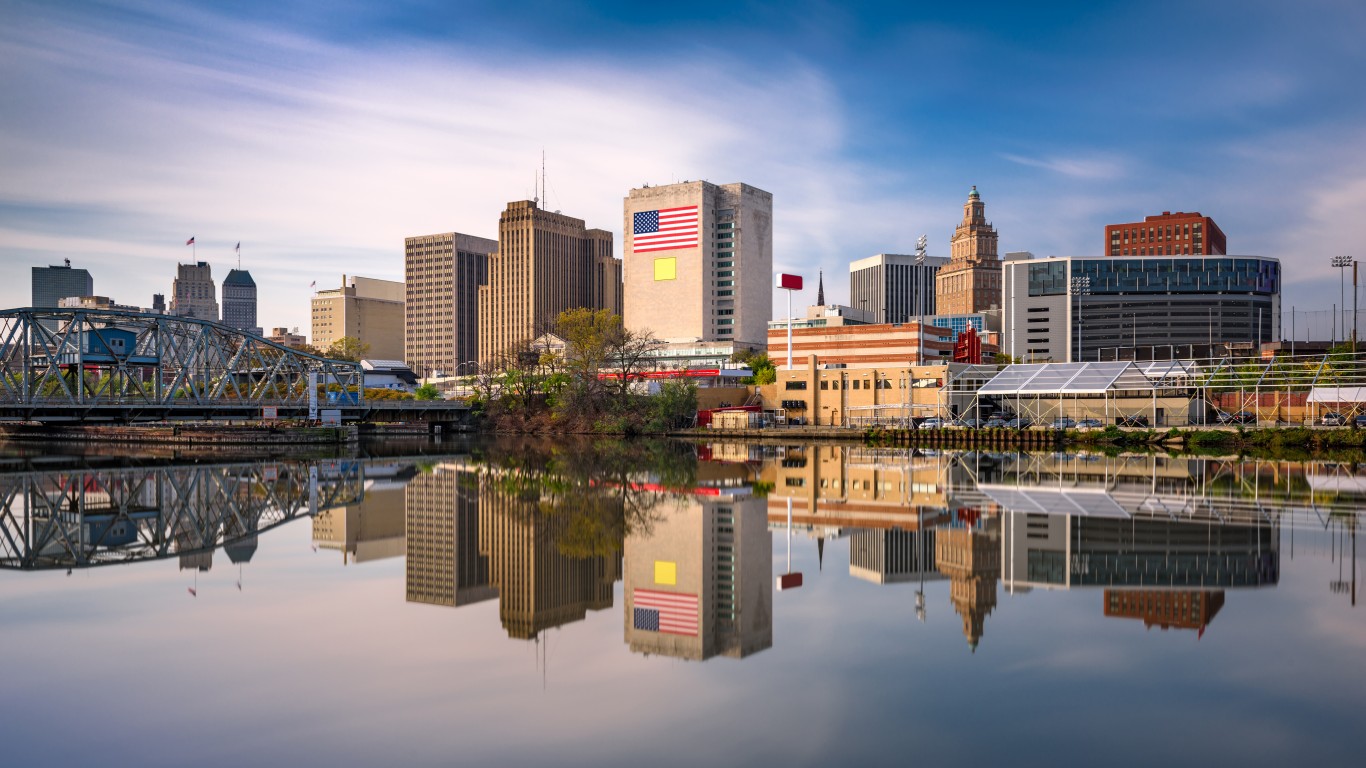
18. New Jersey
> 1-yr. GDP change: -4.1%
> 2020 GDP: $534.1 billion (9th largest)
> Fastest shrinking industry, 2019-2020: Arts, entertainment, recreation, accommodation, and food services (-31.0%)
> Fastest growing industry, 2019-2020: Information (+6.5%)
> April 2021 unemployment: 7.5% (7th highest)
New Jersey’s GDP fell by 4.1% in 2020. The state went from having the eighth largest economy in the country in 2019 with a GDP of $556.7 billion to the ninth largest in 2020 with a GDP of $534.1 billion. Employment in New Jersey fell by 8.4% over the same period, well above the 5.8% decline in employment nationwide.
Arts, entertainment, recreation, accommodation, and food services is vitally important to New Jersey’s economy, and due largely to efforts to contain the spread of the coronavirus, the sector contracted by 31.0% in 2020, posing a 1 percentage point net drag on GDP growth.

17. Connecticut
> 1-yr. GDP change: -4.1%
> 2020 GDP: $241.1 billion (23rd largest)
> Fastest shrinking industry, 2019-2020: Arts, entertainment, recreation, accommodation, and food services (-28.6%)
> Fastest growing industry, 2019-2020: Information (+7.2%)
> April 2021 unemployment: 8.1% (5th highest)
Connecticut’s economy contracted by $10.3 billion in 2020, or 4.1% — a larger decrease than in most states. Growth in sectors like information, agriculture, and utilities were cancelled out by steep declines in arts, entertainment, recreation, accommodation, and food services and transportation and warehousing.
The COVID-19 recession was accompanied by an unemployment crisis in Connecticut. The state shed some 131,000 jobs in 2020. As of April 2021, unemployment in the state stood at 8.1%, well above the 6.1% national jobless rate.
[in-text-ad-2]

16. Maine
> 1-yr. GDP change: -4.1%
> 2020 GDP: $56.4 billion (8th smallest)
> Fastest shrinking industry, 2019-2020: Arts, entertainment, recreation, accommodation, and food services (-27.5%)
> Fastest growing industry, 2019-2020: Utilities (+11.0%)
> April 2021 unemployment: 4.8% (23rd highest)
Maine’s economic output fell by over $2.4 billion in 2020, a 4.1% contraction. Construction and utilities were the only two industries that grew in Maine last year. Meanwhile, several industries, including arts, entertainment, recreation, accommodation, and food services and transportation and warehousing, reported double digit contractions.
Employment declines were also larger in Maine than in much of the country. The state’s workforce shrank by 6.4% in 2020, compared to the 5.8% national employment decline.

15. Pennsylvania
> 1-yr. GDP change: -4.4%
> 2020 GDP: $694.2 billion (6th largest)
> Fastest shrinking industry, 2019-2020: Arts, entertainment, recreation, accommodation, and food services (-30.2%)
> Fastest growing industry, 2019-2020: Utilities (+4.7%)
> April 2021 unemployment: 7.4% (8th highest)
Pennsylvania’s economy contracted by nearly $32 billion in 2020, the fourth largest monetary drop in output of any state. However, Pennsylvania’s economy is sixth largest in the country, and its GDP decline totalled 4.4%, the 15th largest decline among states.
Modest growths in sectors like utilities and finance, insurance, and real estate were not enough to counterbalance steep declines elsewhere in the economy. For example, the state’s arts, entertainment, recreation, accommodation, and food services sector contracted by 30.2% in 2020, accounting for a 1.0 percentage point net economic decline.
[in-text-ad]

14. Wisconsin
> 1-yr. GDP change: -4.5%
> 2020 GDP: $294.2 billion (21st largest)
> Fastest shrinking industry, 2019-2020: Arts, entertainment, recreation, accommodation, and food services (-25.5%)
> Fastest growing industry, 2019-2020: Utilities (+5.2%)
> April 2021 unemployment: 3.9% (12th lowest)
Wisconsin reported a 4.5% decline in GDP in 2020 — a full percentage point above the comparable national contraction. Utilities and finance, insurance, and real estate were the only two sectors to report growth. Meanwhile, the state’s arts, entertainment, recreation, accommodation, and food services, transportation and warehousing, and resource extraction sectors each reported double digit contractions.
Job losses in Wisconsin were somewhat modest in the last year relative to the economic declines. Employment fell by 5.7% in the state in 2020, compared with the 5.8% national employment decline. Currently, Wisconsin’s jobless rate stands at 3.9%, well below the 6.1% U.S. rate.

13. Rhode Island
> 1-yr. GDP change: -4.5%
> 2020 GDP: $51.2 billion (6th smallest)
> Fastest shrinking industry, 2019-2020: Arts, entertainment, recreation, accommodation, and food services (-27.5%)
> Fastest growing industry, 2019-2020: Utilities (+0.6%)
> April 2021 unemployment: 6.3% (17th highest)
Economic output in Rhode Island fell from $53.7 billion in 2019 to $51.2 billion in 2020. The 4.5% economic contraction was a full percentage point steeper than the comparable national economic decline. Job losses were even worse in Rhode Island, as employment fell by 8.8% in 2020, well above the 5.8% national employment decline.
Industries hit hardest in the state were arts, entertainment, recreation, accommodation, and food services and education and health care services, which each posed a net drag of over 1 percentage point on the state’s economic growth. The state’s leisure and hospitality sector shed over a quarter of its workforce in the last year.

12. Nevada
> 1-yr. GDP change: -4.6%
> 2020 GDP: $146.7 billion (18th smallest)
> Fastest shrinking industry, 2019-2020: Agriculture, forestry, fishing and hunting (-21.0%)
> Fastest growing industry, 2019-2020: Mining, quarrying, and oil and gas extraction (+11.3%)
> April 2021 unemployment: 8.0% (6th highest)
Nevada is one of only a dozen states where GDP declined by at least 4.6% in 2020. Tourism is one of the industries hit hardest by the COVID-19 pandemic, and it is also an economic pillar in the state. Only 19 million people visited Las Vegas in 2020, the least since 1989 and less than half the 42.5 million visitors reported in 2019. The arts, entertainment, recreation, accommodation, and food services sector alone accounted for a 3.1 percentage point drag on Nevada’s GDP in 2020.
Job losses were also steep in Nevada in 2020. The state’s leisure and hospitality industry shed 28.1% of its workforce, contributing to the 10.4% total decline in employment, the second largest employment decline of any state. Currently, Nevada’s jobless rate stands at 8.0%, well above the 6.1% U.S. rate.
[in-text-ad-2]

11. New Hampshire
> 1-yr. GDP change: -4.7%
> 2020 GDP: $73.6 billion (11th smallest)
> Fastest shrinking industry, 2019-2020: Arts, entertainment, recreation, accommodation, and food services (-34.2%)
> Fastest growing industry, 2019-2020: Utilities (+8.2%)
> April 2021 unemployment: 2.8% (4th lowest)
New Hampshire’s GDP fell by 4.7% in 2020. The state went from having the 39th largest economy in the country in 2019 with a GDP of $77.2 billion to the 40th largest in 2020 with a GDP of $73.6 billion. Employment in the state fell by 6.7% over the same period, above the 5.8% decline in employment nationwide.
Only a handful of industries in New Hampshire expanded in 2020, and their growth was negligible. Meanwhile, the arts, entertainment, recreation, accommodation, and food services sector alone accounted for a 1.7 percentage point drag on New Hampshire’s GDP in 2020.

10. Tennessee
> 1-yr. GDP change: -4.9%
> 2020 GDP: $312.4 billion (20th largest)
> Fastest shrinking industry, 2019-2020: Arts, entertainment, recreation, accommodation, and food services (-31.8%)
> Fastest growing industry, 2019-2020: Utilities (+8.1%)
> April 2021 unemployment: 5.0% (24th highest)
Tennessee’s GDP fell by 4.9% in 2020. The state went from having the 19th largest economy in the country in 2019 with a GDP of $328.4 billion to the 20th largest in 2020 with a GDP of $312.4 billion. The transportation and warehousing and educational and healthcare services sectors posed considerable drags on the state economy, but the largest detractor from growth was the arts, entertainment, recreation, accommodation, and food services sector that alone accounted for a 1.7 percentage point drag on GDP.
While economic output fell precipitously in Tennessee in 2020, the contraction was not felt as strongly in the job market. Employment in the state fell by just 4.0% last year, compared to the 5.8% decline nationwide.
[in-text-ad]

9. Alaska
> 1-yr. GDP change: -4.9%
> 2020 GDP: $50.6 billion (5th smallest)
> Fastest shrinking industry, 2019-2020: Arts, entertainment, recreation, accommodation, and food services (-28.8%)
> Fastest growing industry, 2019-2020: Utilities (+9.6%)
> April 2021 unemployment: 6.7% (11th highest)
Alaska’s economy contracted by 4.9% in 2020, a steeper decline than in all but eight other states. Alaska is heavily dependent on resource extraction, and the grinding halt of nonessential travel in 2020 gave way to plummeting demand for fuel. Ultimately, global oil prices cratered, and economies like that of Alaska took a hit. Resource extraction alone posed a 1.3 percentage point drag on Alaska’s GDP growth in 2020.
While no industry was more detrimental to economic growth in Alaska than resource extraction, other industries were hit harder. For example, the arts, entertainment, recreation, accommodation, and food services sector contracted by 28.8% in 2020, compared to a 5.8% contraction in resource extraction.
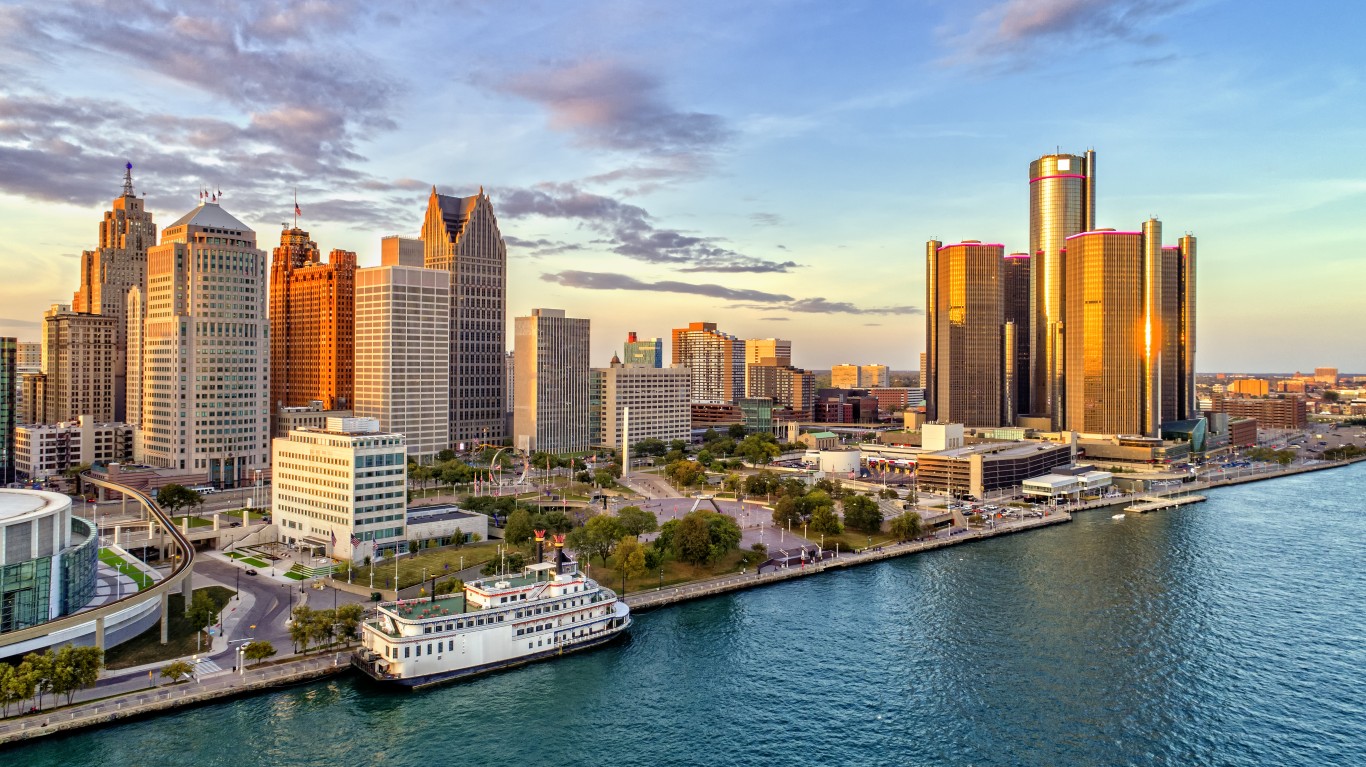
8. Michigan
> 1-yr. GDP change: -5.4%a
> 2020 GDP: $446.2 billion (14th largest)
> Fastest shrinking industry, 2019-2020: Arts, entertainment, recreation, accommodation, and food services (-31.0%)
> Fastest growing industry, 2019-2020: Utilities (+4.4%)
> April 2021 unemployment: 4.9% (24th lowest)
Michigan is one of only eight states to report an economic decline greater than 5% in 2020. Economic output in the state fell by 5.4% from $471.6 billion in 2019 to $446.2 billion in 2020. Manufacturing was the largest drag on growth, with the sector’s output shrinking by 7.5% and detracting a net 1.4 percentage points from GDP.
Employment in Michigan’s manufacturing sector fell by 11% in 2020, more than double the sector’s 5% employment decline nationwide. Partially as a result, the number of people working in Michigan fell by 9.2% in 2020, well above the 5.8% national workforce reduction in 2020. Still, Michigan’s 4.9% unemployment rate remains considerably lower than the 6.1% U.S. rate.

7. Vermont
> 1-yr. GDP change: -5.4%
> 2020 GDP: $28.2 billion (the smallest)
> Fastest shrinking industry, 2019-2020: Arts, entertainment, recreation, accommodation, and food services (-27.9%)
> Fastest growing industry, 2019-2020: Utilities (+5.1%)
> April 2021 unemployment: 2.9% (5th lowest)
Vermont’s economy shrank by 5.4% in 2020, a larger economic decline than in all but half a dozen other states. The only sectors that reported any growth in the state in 2020 were utilities and information. Meanwhile, several industries, including arts, entertainment, recreation, accommodation, and food services and agriculture and forestry, reported double digit declines.
Job losses were also steep in Vermont. Overall employment fell by 9.4% in the state in 2020, the fourth largest decline of any state. Despite the layoffs, unemployment in Vermont stands at just 2.9%, nearly the lowest jobless rate of any state and less than half the 6.1% national rate.
[in-text-ad-2]

6. Louisiana
> 1-yr. GDP change: -5.5%
> 2020 GDP: $226.8 billion (24th largest)
> Fastest shrinking industry, 2019-2020: Arts, entertainment, recreation, accommodation, and food services (-23.9%)
> Fastest growing industry, 2019-2020: Agriculture, forestry, fishing and hunting (+13.3%)
> April 2021 unemployment: 7.3% (9th highest)
Agriculture and utilities are the only two industries that expanded in Louisiana in 2020. That year, the state’s GDP fell by 5.5%, from $240.0 billion in 2019 to $226.8 billion in 2020.
While arts, entertainment, recreation, accommodation, and food services was the fastest shrinking industry in the state in 2020, contracting by 23.9%, resource extraction was a larger detriment to overall GDP growth. Louisiana is one of the 10 largest oil-producing states, and due largely to falling petroleum demand and reduced oil prices during the pandemic, oil production in the state hit its lowest level in over six decades in 2020. Partially as a result, resource extraction presented a 1.0 percentage point drag on GDP in Louisiana last year.

5. West Virginia
> 1-yr. GDP change: -5.5%
> 2020 GDP: $68.4 billion (10th smallest)
> Fastest shrinking industry, 2019-2020: Arts, entertainment, recreation, accommodation, and food services (-23.7%)
> Fastest growing industry, 2019-2020: Utilities (+3.2%)
> April 2021 unemployment: 5.8% (21st highest)
West Virginia’s economy contracted by 5.5% in 2020, more than in all but four other states. Utilities and agriculture were the only sectors that expanded in the state that year. Meanwhile, several sectors, including transportation and warehousing, and arts, entertainment, recreation, accommodation, and food services contracted, reported double digit output declines.
Every sector in the state shed jobs in 2020, and overall employment fell by 6.6%, well above the comparable 5.8% national employment decline. Still, West Virginia’s 5.8% jobless rate is slightly below the 6.1% national rate.
[in-text-ad]

4. New York
> 1-yr. GDP change: -5.9%
> 2020 GDP: $1.4 trillion (3rd largest)
> Fastest shrinking industry, 2019-2020: Arts, entertainment, recreation, accommodation, and food services (-44.8%)
> Fastest growing industry, 2019-2020: Information (+6.2%)
> April 2021 unemployment: 8.2% (3rd highest)
New York’s GDP fell to $1.4 trillion in 2020, down $88.3 billion, or 5.9%, from the previous year — the largest and fourth largest declines of any state, respectively.
The only two sectors in the state that reported growth in 2020 were information and utilities, which expanded by 6.2% and 1.4%, respectively. Meanwhile, the state’s arts, entertainment, recreation, accommodation, and food services sector contracted by a staggering 44.8%, accounting for a net drag on overall growth of 2 percentage points.

3. Oklahoma
> 1-yr. GDP change: -6.1%
> 2020 GDP: $185.9 billion (23rd smallest)
> Fastest shrinking industry, 2019-2020: Mining, quarrying, and oil and gas extraction (-22.5%)
> Fastest growing industry, 2019-2020: Information (+1.3%)
> April 2021 unemployment: 4.3% (17th lowest)
Oklahoma is one of only three states to report a decline in economic output of over 6% in 2020. Oklahoma’s GDP fell 6.1%, from $197.9 billion in 2019 to $185.9 billion in 2020. In most of the country, sectors related to travel and tourism reported the largest declines in 2020. In Oklahoma, however, the resource extraction sector contracted the most.
Oklahoma is the fourth largest oil-producing state, and during the pandemic, demand for fossil fuels plummeted and oil prices cratered. Output in Oklahoma’s mining, quarrying, and oil and gas extraction sector fell by 22.5% in 2020. Meanwhile, retail trade and information were the only sectors in the state to report growth last year, expanding by 1.3% and 1.1%, respectively.
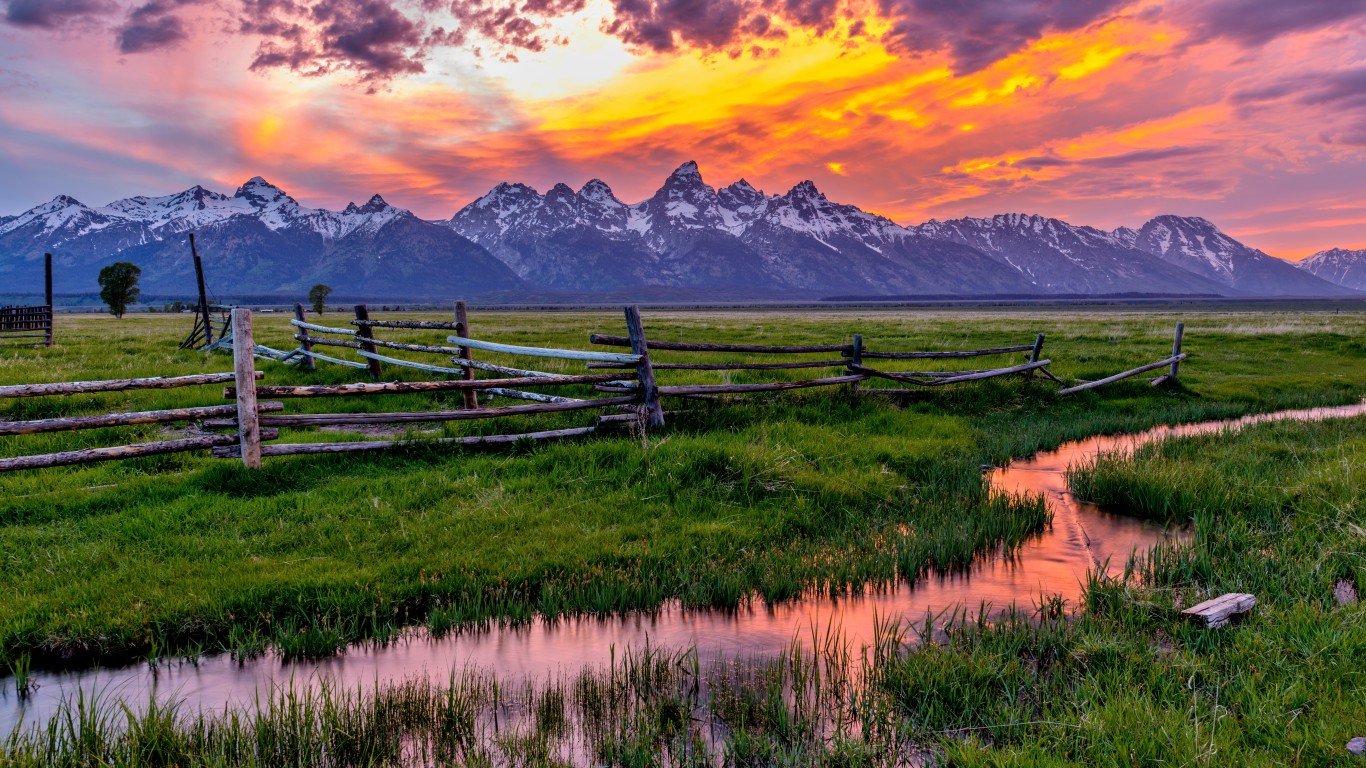
2. Wyoming
> 1-yr. GDP change: -7.0%
> 2020 GDP: $36.5 billion (2nd smallest)
> Fastest shrinking industry, 2019-2020: Mining, quarrying, and oil and gas extraction (-18.8%)
> Fastest growing industry, 2019-2020: Utilities (+4.2%)
> April 2021 unemployment: 5.4% (23rd highest)
Wyoming’s economy contracted by 7.0% in 2020, the second largest decline of any state. Unlike most states, where the arts, entertainment, recreation, accommodation, and food services sector shrank more than any other, in Wyoming, mining, quarrying, and oil and gas extraction contracted the most. The sector reported an 18.8% decline in output and posed a 4.7 percentage point drag on GDP.
Every sector in Wyoming reported job losses last year, resulting in a 6.1% decline in employment, slightly higher than the comparable 5.8% decline nationwide. Still, the state’s 5.4% unemployment rate in April is considerably lower than the 6.1% U.S. jobless rate.
[in-text-ad-2]

1. Hawaii
> 1-yr. GDP change: -8.0%
> 2020 GDP: $75.9 billion (13th smallest)
> Fastest shrinking industry, 2019-2020: Arts, entertainment, recreation, accommodation, and food services (-38.4%)
> Fastest growing industry, 2019-2020: Agriculture, forestry, fishing and hunting (+6.4%)
> April 2021 unemployment: 8.5% (the highest)
Hawaii reported by far the largest economic contraction of any state in 2020. Hawaii’s GDP fell from $82.4 billion in 2019 to $75.9 billion in 2020, an 8.0% drop. Tourism, an industry that was effectively ground to a halt during the pandemic, is an economic pillar in Hawaii. Due to efforts to contain the spread of COVID-19, Hawaii reported only 2.7 million visitors in 2020, down from 10.2 million in 2019. Over the same period, the state’s arts, entertainment, recreation, accommodation, and food services contracted by 38.4%.
The economic contraction was accompanied by steep job cuts in Hawaii last year. Overall employment fell by a nation-leading 16.1% in 2020, nearly three times the national 5.8% employment decline. Currently, Hawaii’s 8.5% jobless rate is the highest in the nation.
Methodology
To determine the fastest growing and shrinking state economies, 24/7 Wall St. reviewed data on one-year change in real gross domestic product from the Bureau of Economic Analysis. States were ranked based on the percentage change in real GDP from 2019 to 2020. Data on industry-specific real GDP also came from the BEA. Supplemental data on population came from the U.S. Census Bureau’s Population and Housing Estimates program. Data on average annual employment and the seasonally adjusted monthly unemployment rate each came from the Bureau of Labor Statistics.
Sponsored: Attention Savvy Investors: Speak to 3 Financial Experts – FREE
Ever wanted an extra set of eyes on an investment you’re considering? Now you can speak with up to 3 financial experts in your area for FREE. By simply
clicking here you can begin to match with financial professionals who can help guide you through the financial decisions you’re making. And the best part? The first conversation with them is free.
Click here to match with up to 3 financial pros who would be excited to help you make financial decisions.
Thank you for reading! Have some feedback for us?
Contact the 24/7 Wall St. editorial team.
 24/7 Wall St.
24/7 Wall St. 24/7 Wall St.
24/7 Wall St.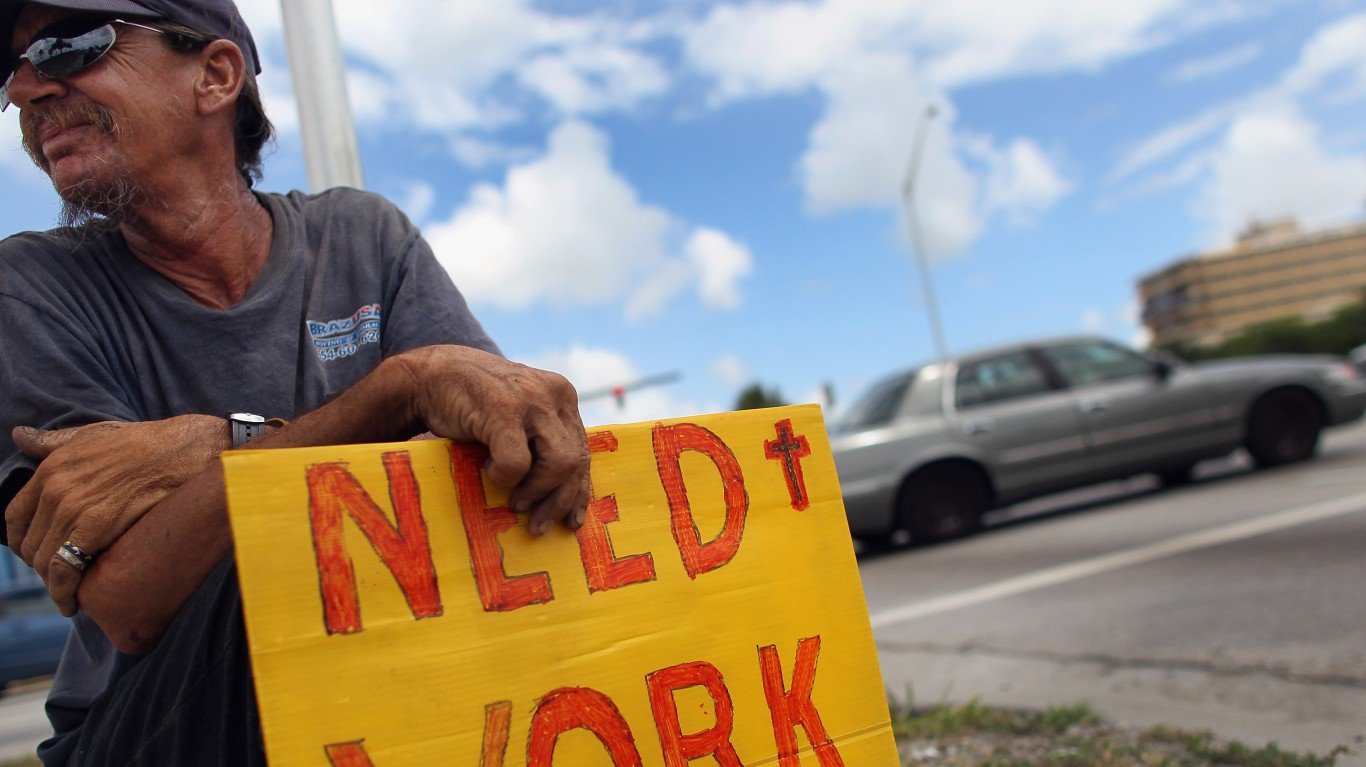 24/7 Wall St.
24/7 Wall St.